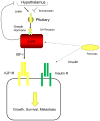A tale of two receptors: insulin and insulin-like growth factor signaling in cancer
- PMID: 25303978
- PMCID: PMC4498265
- DOI: 10.1158/1078-0432.CCR-14-2056
A tale of two receptors: insulin and insulin-like growth factor signaling in cancer
Abstract
Inhibition of the type I IGF receptor (IGF1R) has been the focus of numerous clinical trials. Two reports in this issue describe the results of phase I trials of an IGF1R tyrosine kinase inhibitor OSI-906. This commentary will describe the complex endocrine changes induced by these types of agents.
©2014 American Association for Cancer Research.
Conflict of interest statement
Figures


Comment on
-
Phase I study of intermittent oral dosing of the insulin-like growth factor-1 and insulin receptors inhibitor OSI-906 in patients with advanced solid tumors.Clin Cancer Res. 2015 Feb 15;21(4):693-700. doi: 10.1158/1078-0432.CCR-14-0265. Epub 2014 Sep 10. Clin Cancer Res. 2015. PMID: 25208878 Clinical Trial.
-
A phase I study of continuous oral dosing of OSI-906, a dual inhibitor of insulin-like growth factor-1 and insulin receptors, in patients with advanced solid tumors.Clin Cancer Res. 2015 Feb 15;21(4):701-11. doi: 10.1158/1078-0432.CCR-14-0303. Epub 2014 Sep 11. Clin Cancer Res. 2015. PMID: 25212606 Clinical Trial.
References
-
- Jones RL, Kim ES, Nava-Parada P, Alam S, Johnson FM, Stephens AW, et al. Phase I study of intermittent oral dosing of the insulin-like growth factor-1 and insulin receptors inhibitor OSI-906 in patients with advanced solid tumors. Clin Cancer Res. 21:xxx–xxx. - PubMed
-
- Puzanov I, Lindsay CR, Goff L, Sosman J, Gilbert J, Berlinn J, et al. A Phase I study of continuous oral cosing of OSI-906, a dual inhibitor of insulin-like growth factor-1 and insulin receptors in patients with advanced solid tumors. Clin Cancer Res. 21:xxx–xxx. - PubMed
-
- Langer CJ, Novello S, Park K, Krzakowski M, Karp DD, Mok T, et al. Randomized, phase III trial of first-line figitumumab in combination with paclitaxel and carboplatin versus paclitaxel and carboplatin alone in patients with advanced non–small-cell lung cancer. J Clin Oncol. 2014;32:2059–66. - PMC - PubMed
Publication types
MeSH terms
Substances
Grants and funding
LinkOut - more resources
Full Text Sources
Other Literature Sources

